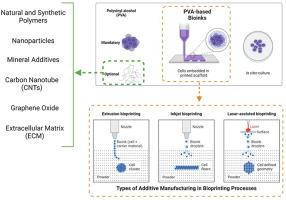基于pva的3D生物打印生物墨水:其在组织工程中的应用综述
Q1 Computer Science
引用次数: 0
摘要
3D生物打印是一种创新的方法,克服了传统方法的局限性,用于创建细胞负载生物材料和结构。它允许制造复杂的和生物活性的组织结构。这篇综述的目的是在3D生物打印框架内对聚乙烯醇(PVA)为基础的生物墨水进行全面的评价。pva基生物墨水具有显著的生物相容性、生物可降解性和促进细胞生长和分化的能力。这些特性使它们适合于许多组织工程应用。该研究评估了PVA生物墨水的物理化学和生物学特性,包括它们如何与其他材料结合,如明胶、几丁质、壳聚糖、海藻酸盐、琼脂糖、纤维素、κ-卡拉胶、甲基丙烯酸酯、纳米颗粒、矿物添加剂、碳纳米管、氧化石墨烯和细胞外基质成分。此外,本文评估了市场可用性和增强打印分辨率的好处,以及复杂性、对支持浴的依赖性和污染风险带来的挑战。本文综述的目的是为了引起人们对聚乙烯醇基生物连接材料性能的关注,并为进一步研究提高聚乙烯醇基生物连接材料在组织工程和再生医学中的有效性提供指导。本文章由计算机程序翻译,如有差异,请以英文原文为准。

PVA-based bioinks for 3D bioprinting: A comprehensive review of their applications in tissue engineering
3D bioprinting is an innovative approach that overcomes the limitations of traditional methods for creating cell-laden biomaterials and constructs. It allows for the fabrication of complex and biologically active tissue structures. This review aims to provide a comprehensive evaluation of polyvinyl alcohol (PVA)-based bioinks within a 3D bioprinting framework. PVA-based bioinks exhibit remarkable properties, such as biocompatibility, biodegradability, and the ability to enhance cell growth and differentiation. These properties make them appropriate for many tissue engineering applications. The study evaluates the physicochemical and biological properties of PVA bioinks, including how they combine with other materials such as gelatin, chitin, chitosan, alginate, agarose, cellulose, κ-carrageenan, methacrylate, nanoparticles, mineral additives, carbon nanotubes, graphene oxide, and extracellular matrix components. Furthermore, this review evaluates the benefits of market availability and enhanced printing resolution, in addition to the challenges posed by complexity, dependency on support baths, and the risk of contamination. The objective of this review is to draw attention to the capabilities of PVA-based bioinks and provide guidelines for future research to improve the effectiveness of these materials in tissue engineering and regenerative medicine.
求助全文
通过发布文献求助,成功后即可免费获取论文全文。
去求助
来源期刊

Bioprinting
Computer Science-Computer Science Applications
CiteScore
11.50
自引率
0.00%
发文量
72
审稿时长
68 days
期刊介绍:
Bioprinting is a broad-spectrum, multidisciplinary journal that covers all aspects of 3D fabrication technology involving biological tissues, organs and cells for medical and biotechnology applications. Topics covered include nanomaterials, biomaterials, scaffolds, 3D printing technology, imaging and CAD/CAM software and hardware, post-printing bioreactor maturation, cell and biological factor patterning, biofabrication, tissue engineering and other applications of 3D bioprinting technology. Bioprinting publishes research reports describing novel results with high clinical significance in all areas of 3D bioprinting research. Bioprinting issues contain a wide variety of review and analysis articles covering topics relevant to 3D bioprinting ranging from basic biological, material and technical advances to pre-clinical and clinical applications of 3D bioprinting.
 求助内容:
求助内容: 应助结果提醒方式:
应助结果提醒方式:


